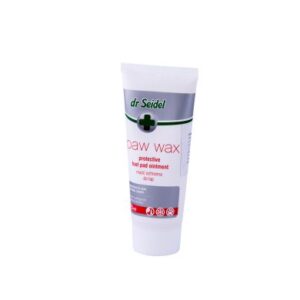Marfloxin 5 mg, (marbofloxacin 5 mg) for Dogs and Cats 10 tablets
Description
Light brownish-yellow, marbled, round, biconvex with beveled edges and a notch for division on one side, white and dark blotches are possible.
The tablets can be divided into equal halves.
Composition
1 tablet (70 mg) contains active ingredient:
marbofloxacin – 5 mg.
Excipients: lactose, povidone K 90, dry yeast, meat flavoring, crospovidone, hydrogenated castor oil, colloidal silicon dioxide, magnesium stearate.
Pharmacological properties
ATC vet classification code QJ01 – antibacterial veterinary drugs for systemic use. QJ01MA93 – Marbofloxacin.
Marbofloxacin is a synthetic, bactericidal antimicrobial substance that belongs to the group of fluoroquinolones. The action of marbofloxacin is based on the suppression of DNA gyrase and topoisomerase IV. It is effective against a wide range of gram-positive bacteria (in particular streptococcus and staphylococcus) and gram-negative bacteria (Escherichia coli, Citrobacter freundii, Proteus spp., Klebsiella spp., Shigella spp., Pasteurella spp., Pseudomonas spp.), As well as Mycoplasma spp. …
A detailed literature on the susceptibility of microorganisms, derived from two conducted European field studies, during which hundreds of pathogens susceptible to marbofloxacin for cats and dogs were examined, were published in 2009.
| Microorganism names | MIC (μg / ml) |
| Staphylococcus intermedius | 0.23-0.25 |
| Escherichia coli | 0.125-0.25 |
| Pasteurella multocida | 0.04 |
| Pseudomonas aeruginosa | 0.94 |
Cut-off values were determined to be ≤1 μg / ml for susceptible organisms, 2 μg / ml for moderately sensitive organisms and ≥4 μg / ml for resistant organisms.
Marbofloxacin is not active against anaerobes, fungi, or yeast. Resistance has been observed among streptococcal strains. Resistance to fluoroquinolones develops as a result of chromosomal mutations, taking into account three mechanisms: a decrease in the permeability of the bacterial wall, the expression of an efflux pump, or a mutation of enzymes responsible for binding molecules.
After oral administration to dogs and cats at the recommended dose of 2 mg / kg, marbofloxacin is rapidly absorbed and reaches a maximum plasma concentration of 1.5 μg / ml within 2 hours.
Bioavailability is close to 100%.
Marbofloxacin weakly binds to plasma proteins (less than 10%), is well distributed throughout the body and in most tissues (liver, kidneys, skin, lungs, bladder, uterus, gastrointestinal tract), it reaches a higher concentration than in plasma. Marbofloxacin is excreted slowly (t½ß = 14 hours in dogs and 10 hours in cats), mainly in active form in urine (2/3) and feces (1/3).
Application
Dogs: treatment of animals for diseases of the urinary tract and respiratory tract, skin and soft tissues (pyoderma of skin folds, impetigo, folliculitis, furunculosis, cellulitis) caused by microorganisms sensitive to marbofloxacin.
Cats: treatment of animals for diseases of the respiratory system, skin and soft tissues caused by microorganisms sensitive to marbofloxacin.
Dosage
Orally. The recommended dose is 2 mg of marbofloxacin per 1 kg of body weight per day (1 tablet per 2.5 kg of body weight of an animal per day). If necessary, only in dogs, the use of a combination of whole or half tablets of different dosages (5 mg, 20 mg or 80 mg) will provide an accurate dosage, namely:
| Animal body weight (kg) | Number of tablets (dose 5 mg) | Recommended dose for marfloxacin (mg / kg) |
| 1 – 1.5 | 0.5 | 1.7 – 2.5 |
| > 1,5 – 2,5 | 1 | 2.0 – 3.3 |
| > 2,5 – 3,5 | 1.5 | 2.1 – 3.0 |
| > 3,5 – 5,0 | 2 | 2.0 – 2.9 |
| > 5,0 – 7,0 | 3 | 2.1 – 3.0 |
| > 7,0 – 9 | 4 | 2.2 – 2.9 |
To correctly determine the dose, it is necessary to accurately determine the body weight of the animal (as far as possible) in order to avoid an insufficient dose.
The course of treatment for dogs is:
- in the treatment of diseases of the skin and soft tissues – at least 5 days or maximum 40 days, depending on the course of the disease;
- in the treatment of diseases of the urinary tract organs – 10-28 days, depending on the course of the disease;
- in the treatment of respiratory diseases – 7-21 days, depending on the course of the disease.
The course of treatment for cats is:
- in the treatment of diseases of the skin and soft tissues – 3-5 days;
- in the treatment of respiratory diseases – 5 days.
Contraindications
Do not administer to animals with hypersensitivity to marbofloxacin or other fluoroquinolones or to an auxiliary substance of the drug.
Do not use in dogs of small and medium breeds in the first 12 months of life, large breeds (Danish Great Dane, Briard, Bernese Shepherd Dog, Bouvier and English Mastiff) – in the first 18 months.
Do not use in cats in the first 16 weeks of life.
Warning
Special precautions for use
High doses of some fluoroquinolones may have epileptogenic potential. Should be used with caution in dogs and cats with epilepsy. However, no serious side effects are expected when the drug is used in dogs and cats at the recommended therapeutic dose. In particular, no joint lesions were found in clinical studies using the recommended dose.
When using the drug, generally accepted principles for the use of antimicrobial drugs should be taken into account. Fluoroquinolones are prescribed to treat clinical conditions that are difficult to treat, or conditions that may not respond well to other classes of antimicrobial drugs.
Whenever possible, fluoroquinolones should only be used in conjunction with a susceptibility test.
The use of the drug in violation of the instructions given in this brief description of the drug may lead to an increase in the number of bacteria resistant to fluoroquinolones and a decrease in the effectiveness of treatment with other quinolones due to the presence of cross-resistance.
Use during pregnancy, lactation
In studies on laboratory animals (rats, rabbits), there was no evidence of the teratogenic, embryotoxic or toxic effect of marbofloxacin on the maternal body when used in therapeutic doses. However, special studies on the use of the drug in pregnant or lactating cats and dogs have not been carried out. Therefore, the use of these species of animals is allowed only after a careful assessment of the benefit / risk ratio by the responsible veterinarian.
Interaction with other drugs or other forms of interaction
It is known that fluoroquinolones interact with metal cations after oral administration (aluminum, calcium, magnesium, iron). In such cases, the bioavailability of marbofloxacin may decrease. The clearance of theophylline can be significantly reduced when used concomitantly with marbofloxacin.
In case of overdose, acute neurological disorders may occur, requiring symptomatic treatment.
User warning
People with hypersensitivity to fluoroquinolones should avoid any contact with the drug. If accidentally swallowed, seek medical advice immediately and show the label and / or package insert to the doctor.
Wash your hands after use.
Release form
There are 10 tablets in a blister, 1 or 10 blisters in a cardboard box.
Storage
Dry, dark place, out of the reach of children, in the original packaging at a temperature of 8 ° C to 25 ° C.
Shelf life is 3 years.
Shelf life of the tablet, divided into two halves: 5 days.
For use in veterinary medicine!

































